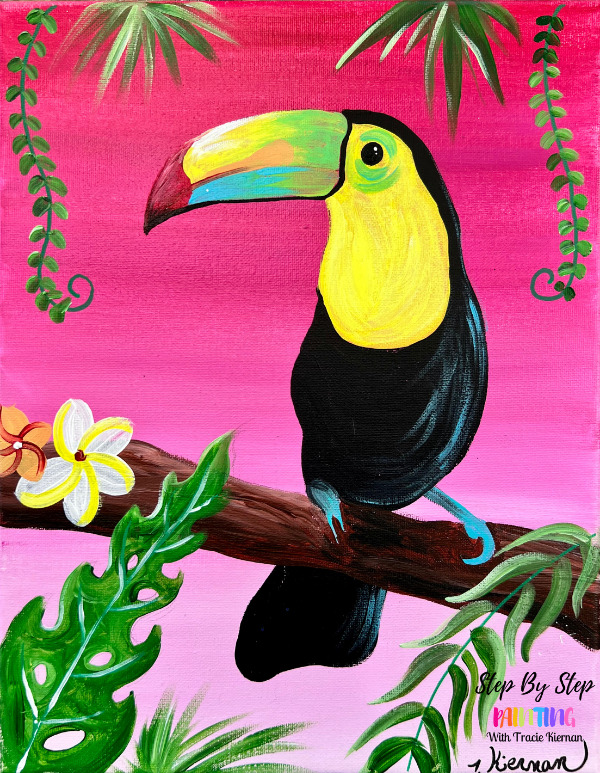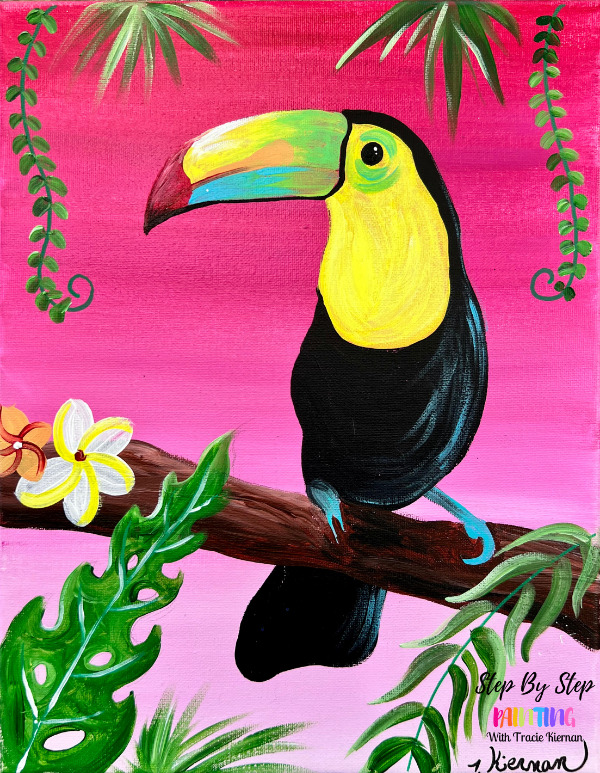
Learn how to create a beautiful, vibrant toucan painting with acrylics! This is a beginner painting tutorial that includes a free traceable template download for the toucan.
This particular painting is a little more advanced than my first how to paint a toucan painting! You can see an easy version of this over here (there is no video for that tutorial). I also have a “How To Draw A Toucan” tutorial!
I love the hot pink gradient background in this! It makes all the bright colors in the toucan and the black pop amazingly! It’s a great painting for the summer or as a year round design.
Enjoy and happy painting!

Materials Needed
How To Paint A Toucan

Paint a tropical toucan with a vibrant hot pink background.
Materials
- 11 x 14 Canvas
- Acrylic Paint
- Green POSCA Paint Pen (optional)
- Traceable Template
- Pencil
- Graphite Paper
Colors
- Alizarin Crimson Hue Permanent
- Medium Magenta
- Titanium White
- Mars Black
- Cadmium Yellow Light Hue
- Light Blue Permanent
- Hooker's Green Hue Permanent
- Burnt Umber
Brushes
- #4 Round Brush
- 3/4" Flat Wash Brush
- 10/0 Spotter Brush
Download this tutorial!
You can download a PDF version of this tutorial, download the video, traceables in different sizes and a picture of the original painting!
Color Palette
I used Liquitex BASICS for this painting. If you are using a different brand, you can use the color swatch below to try to match your colors.
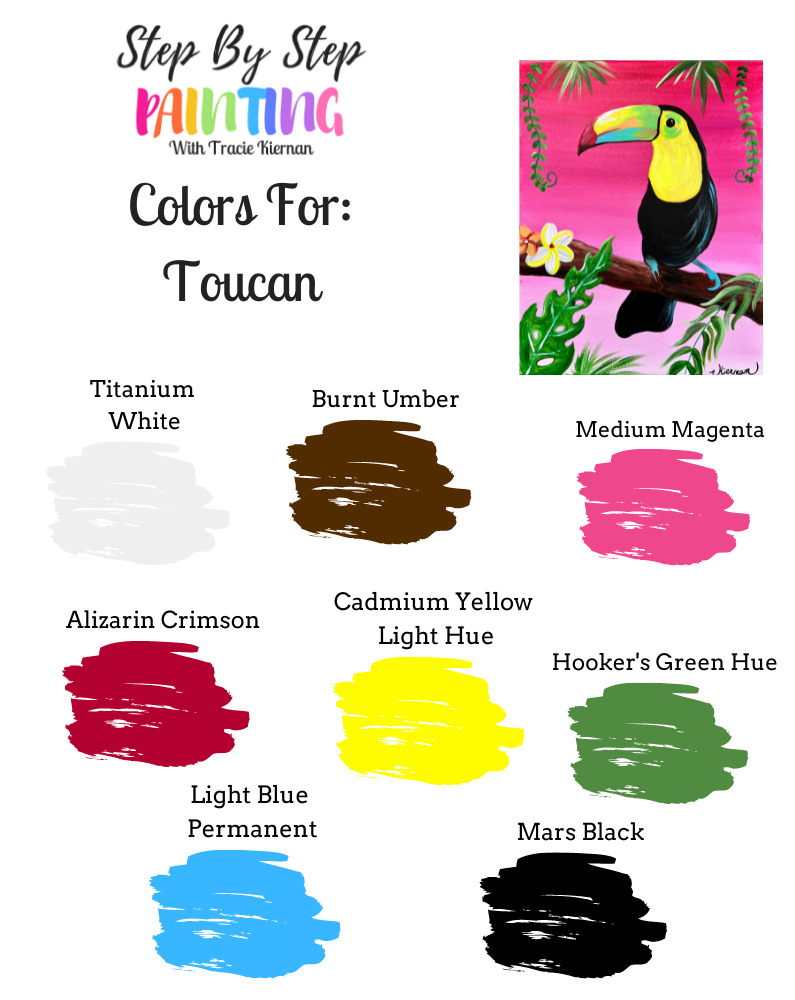
Using Craft Paints?
If you are using craft paints such as Apple Barrel paints, I would suggest subbing to these colors:
- White
- Nutmeg Brown
- Bright Magenta
- Flag Red (mix a little pink into this)
- Yellow Flame
- Holly Branch
- Parrot Blue
- Black
Traceable
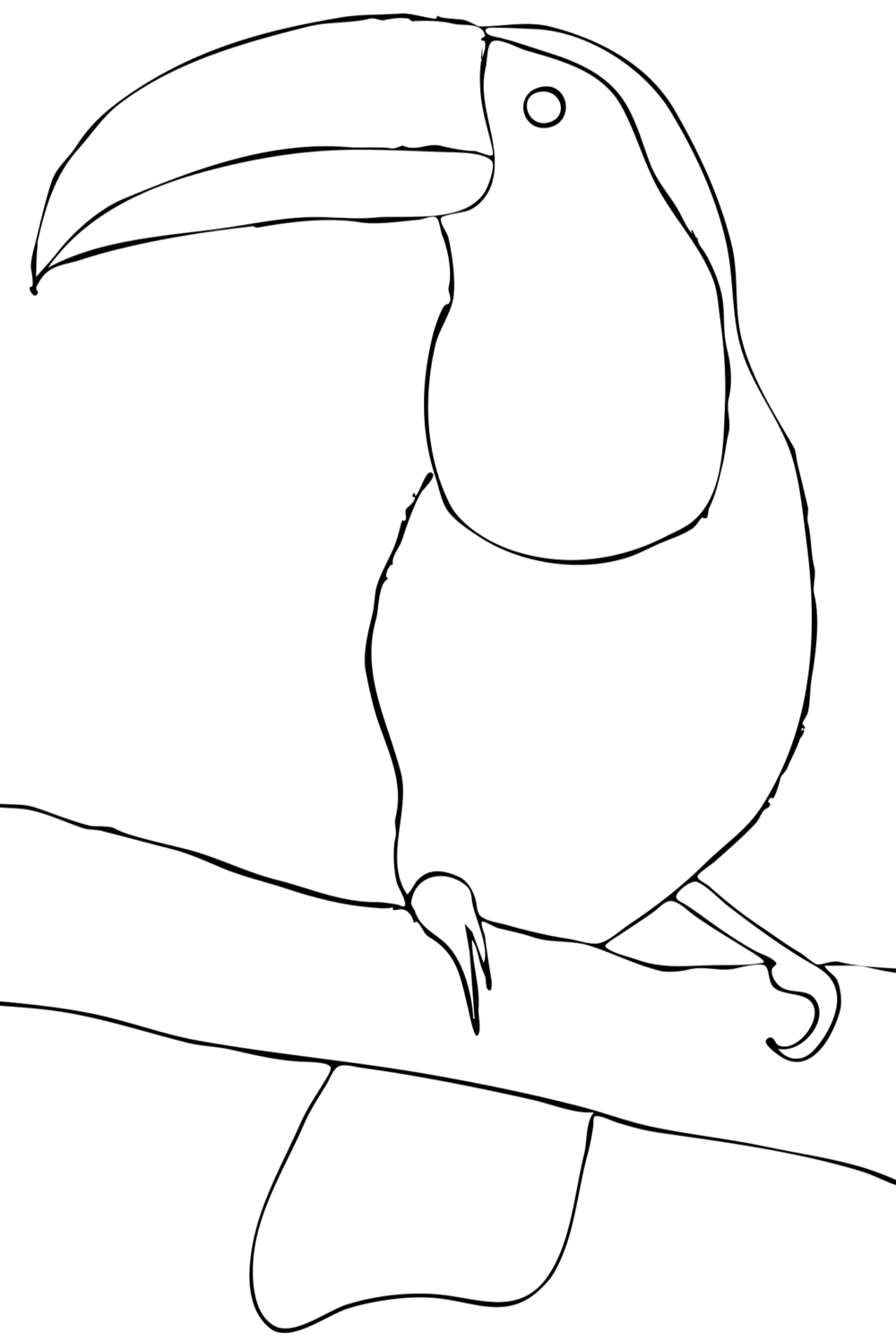
Directions At A Glance
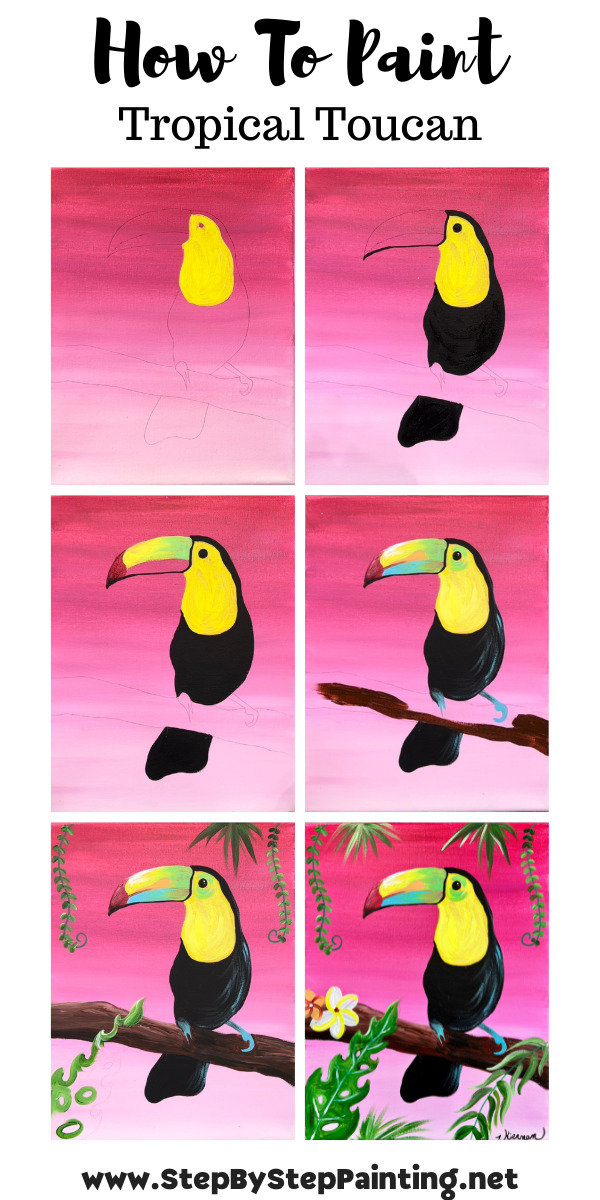
Video
Step By Step Directions
1. Paint The Background
The background in this painting is a gradient of dark red to pink to light white-pink. Load your palette with the colors: alizarin crimson hue, medium magenta and titanium white.

Load your 3/4″ flat wash brush for the alizarin crimson. Paint left and right strokes starting from the bottom. Go up about a third of the canvas. Note: I painted this background upside down. The dark part really is going to be at the top and the light part will be on the bottom.

Then load your brush with medium magenta. Blend that with the alizarin crimson so the color fades to pink.

Then load your brush with titanium white. Blend the white with the medium magenta so the color blends to a lighter pink.
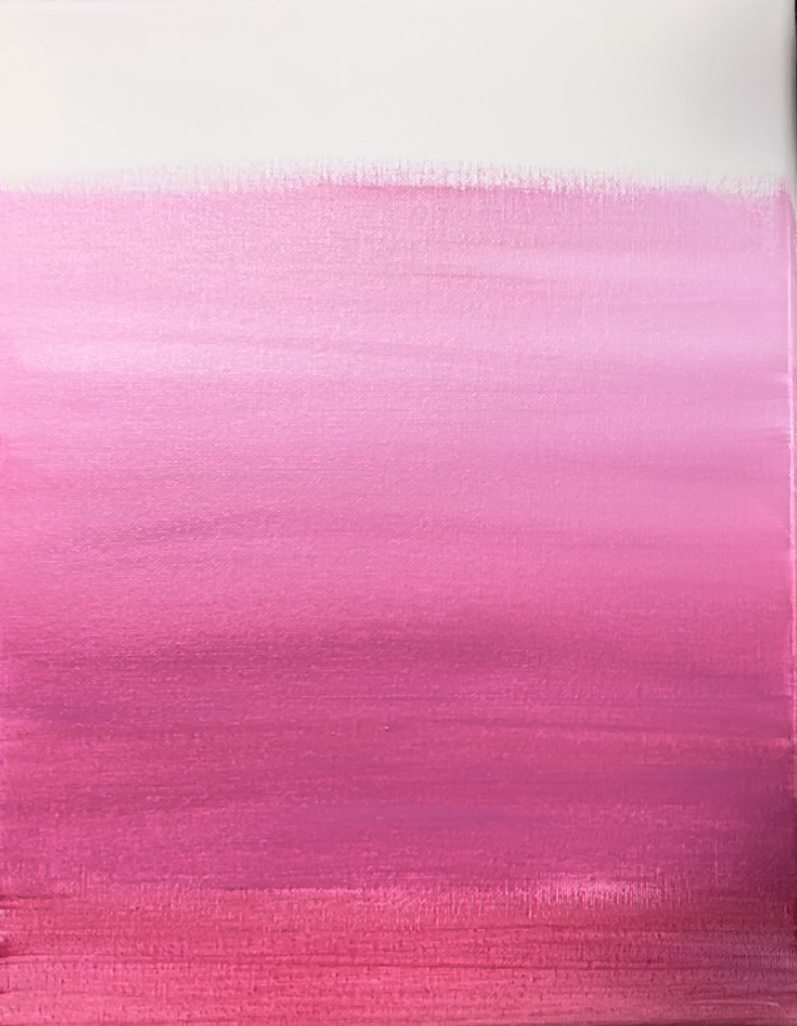
Continue to add more titanium white and keep blending the color up to the top of the canvas.
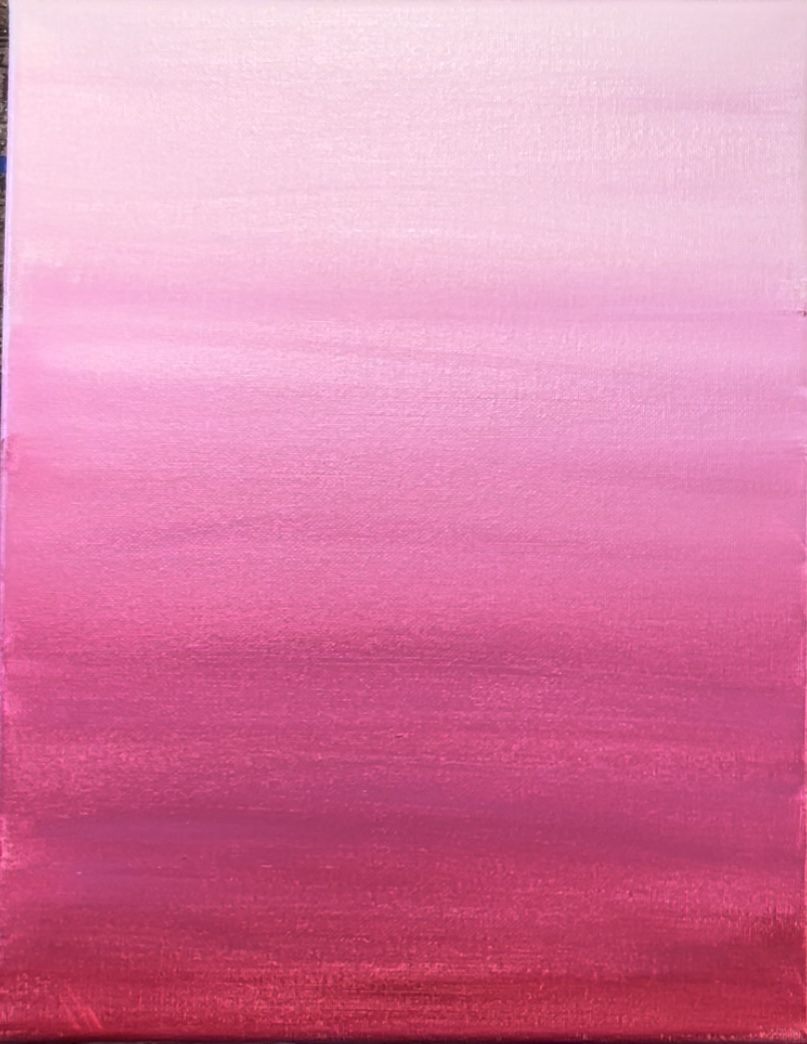
2. Transfer Toucan Template To Canvas
Wait for the background to dry. Then print out the toucan template. The PDF download is optimized to print on one sheet of paper and transfer to an 11 x 14 canvas.
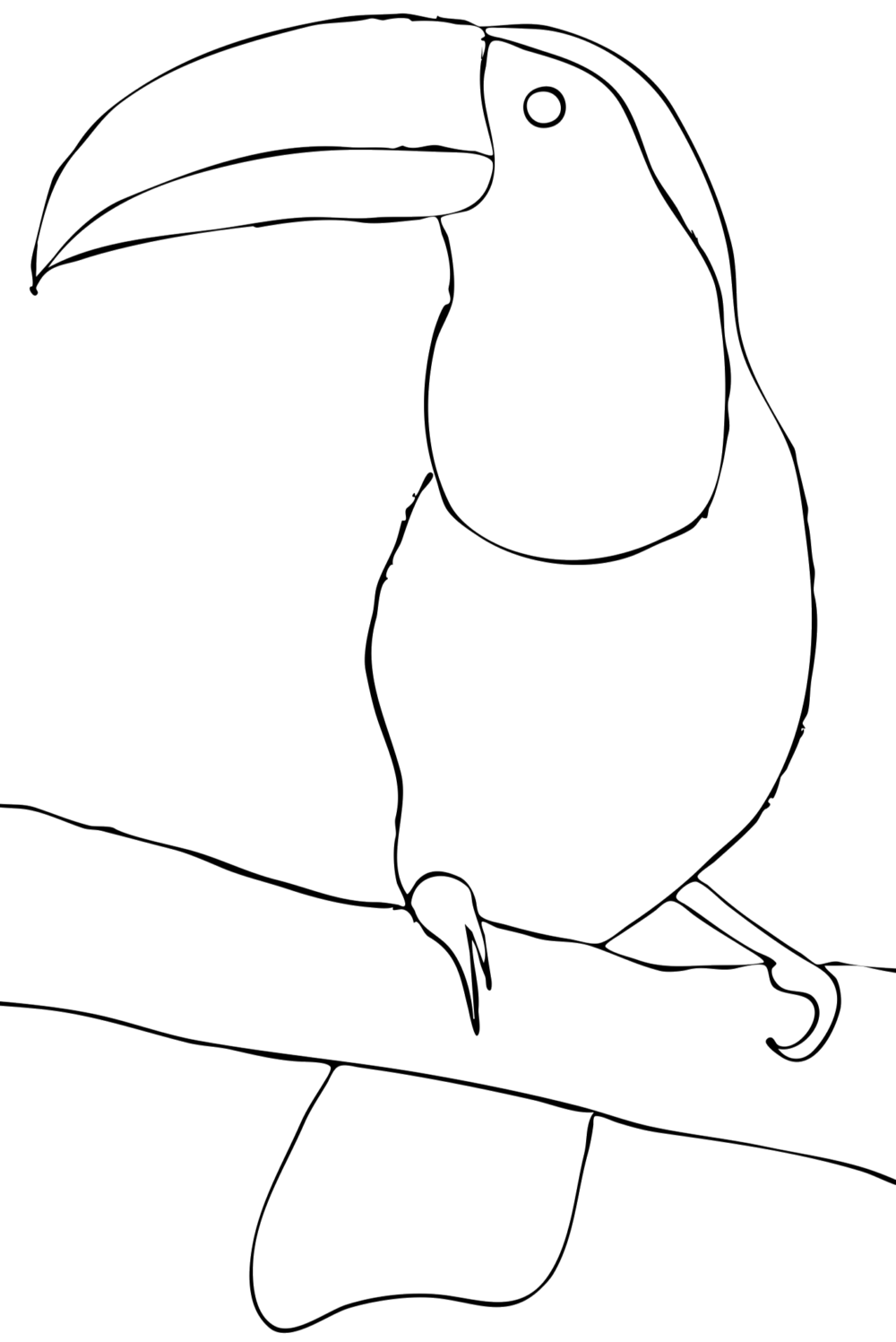
Position the toucan so that it is slightly off center to the right. Then place a sheet of graphite paper below the toucan and trace with a pencil. If you don’t have graphite paper, you can rub pencil on the back of the toucan.

Then use your pencil to extend the branch to the edges of the canvas.

3. Paint The Yellow Chest Area
Load your palette with cadmium yellow light and titanium white. Use a #4 round brush and double load it with the yellow and the white. Paint the yellow chest area of the bird.

Go around the eye. Add a second coat if necessary.

4. Paint Black Area
Use the #4 round brush and mars black to paint the black area of the bird.

Paint the tail. Go around the feet and the branch.


Then use a 10/0 round brush (detail round brush) to paint the eye. Outline the bottom and right vertical edge of the beak. You can also do this step with a paint pen.

5. Paint Beak
Load your palette with: alizarin crimson, cadmium yellow light and light blue permanent.
Use your #4 round brush to paint the far left edge of the beak. Paint an “S” line to divide the edge then fill it in solid with the red.

Rinse the brush. Then load it into the cadmium yellow light. Paint the top part of the beak. Paint strokes going in a curved, elongated direction. Leave the far right part of the beak blank.

Mix green on your palette. Mix about 1 part cadmium yellow light and 1 part light blue permanent to make a light green. Blend the green into the yellow part of the beak and paint all the way to the far right.

Then rinse and dry your #4 round brush. Paint light blue permanent on the bottom part of the beak. Paint curved stroke from the left to the right and leave a gap open.

Then blend green into the blue on the far right.

Next, mix orange on your palette. Mix about 3 parts yellow and 1 part alizarin crimson. Paint an orange area in the middle top area of the beak.
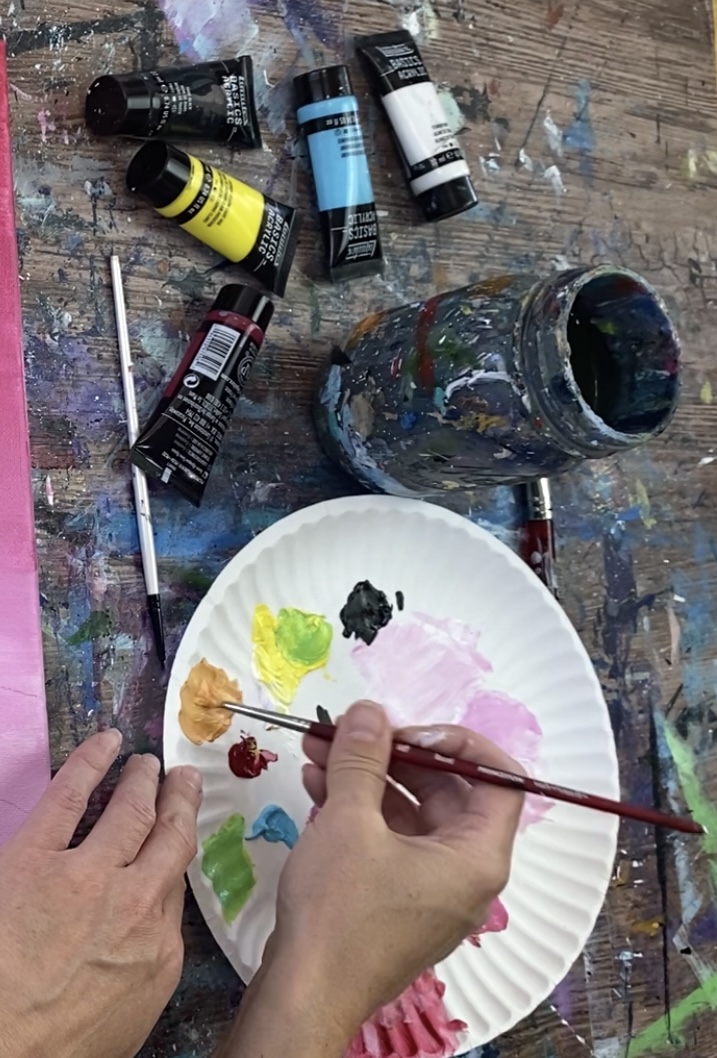
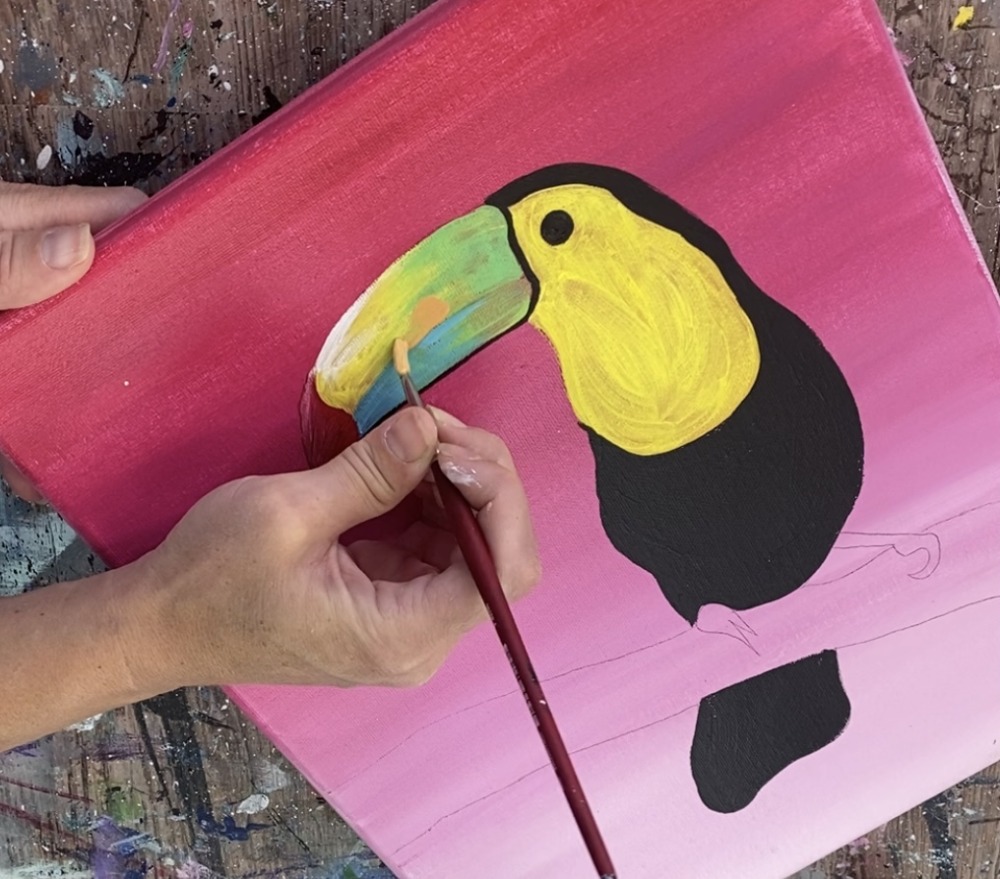
Then use the red to paint a line that goes down the middle almost half way across the beak.
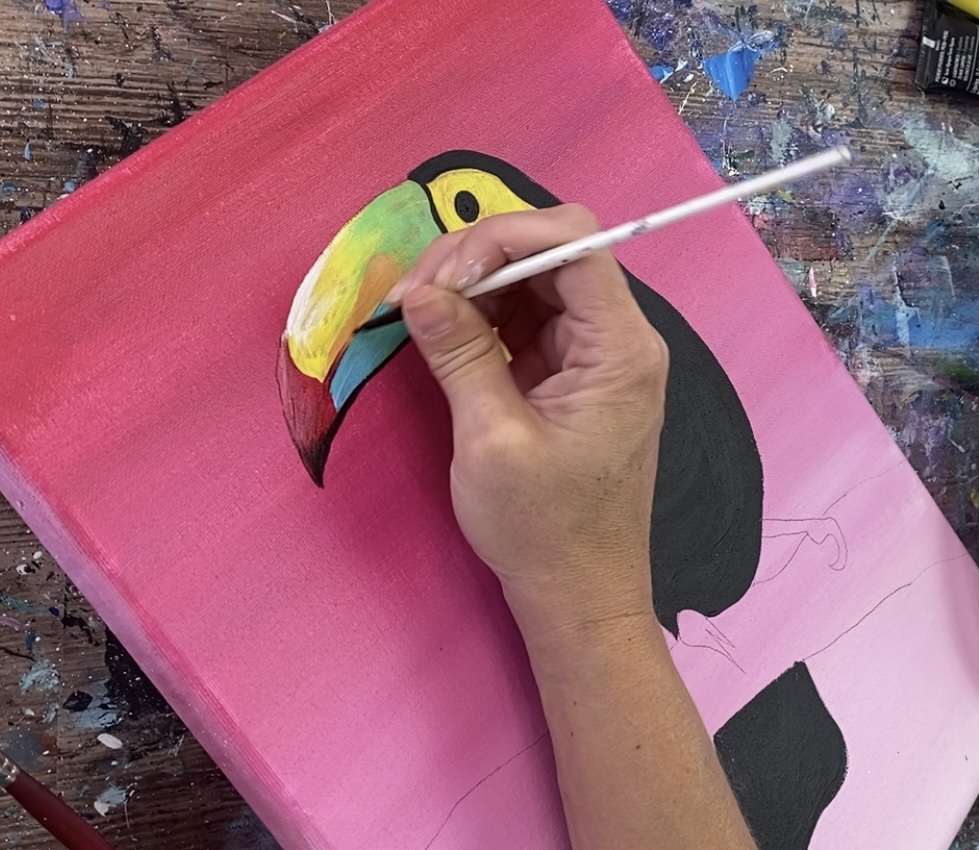

6. Paint details around eye
Use the 10/0 round brush and titanium white to paint two very small dots in the upper right part of the eye.
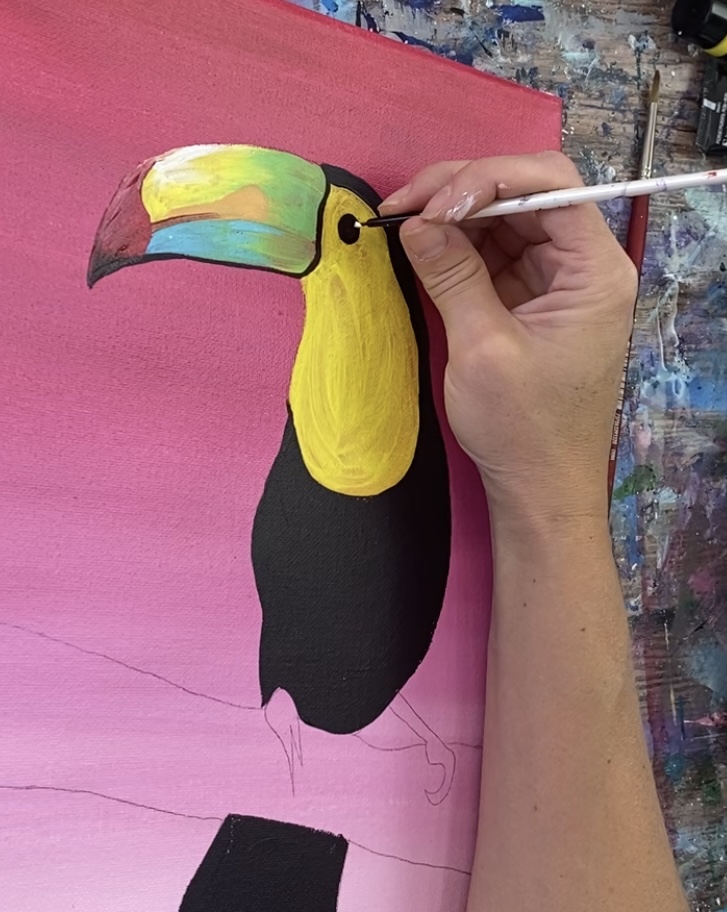

Then use your #4 round brush and your light green mixture you used in the beak to paint curved strokes around the eye.
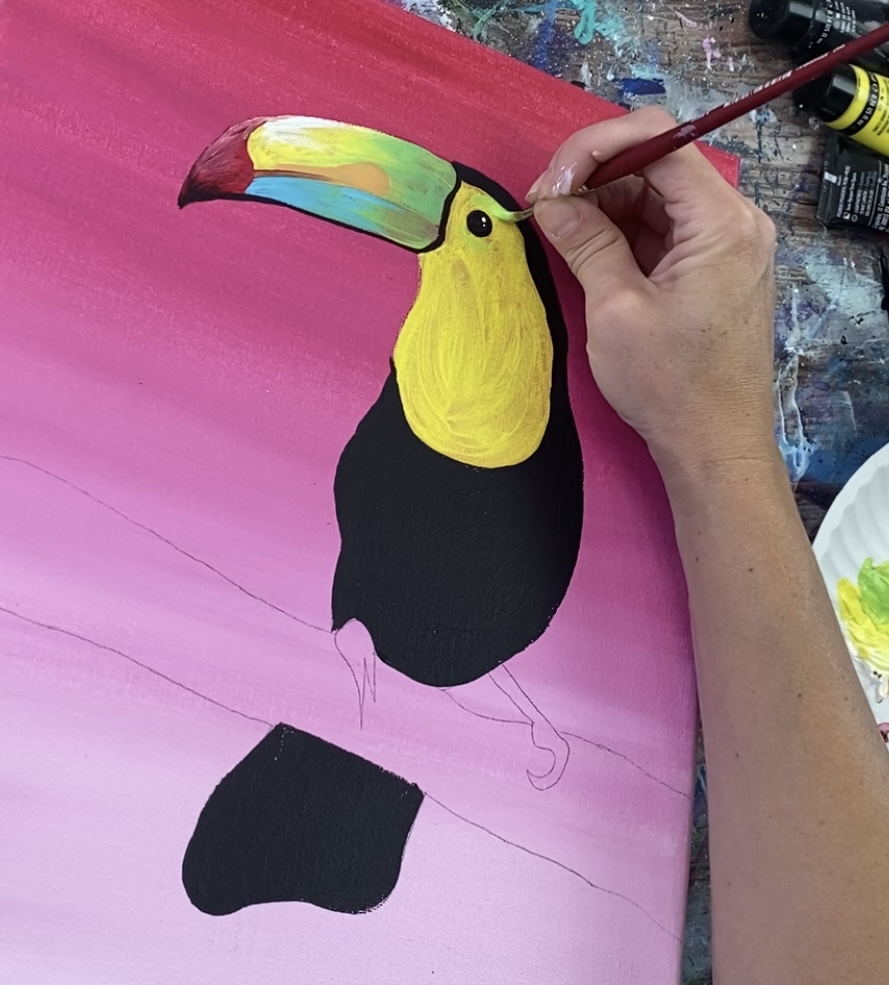

7. Paint Feather Highlights
Use your #4 round brush and light blue permanent to paint feather strokes/ highlights on the right side of the bird on its back. Do this “dry brush style”. Load your brush in the paint but wipe some of the paint off to create the dry, feathery stroke.
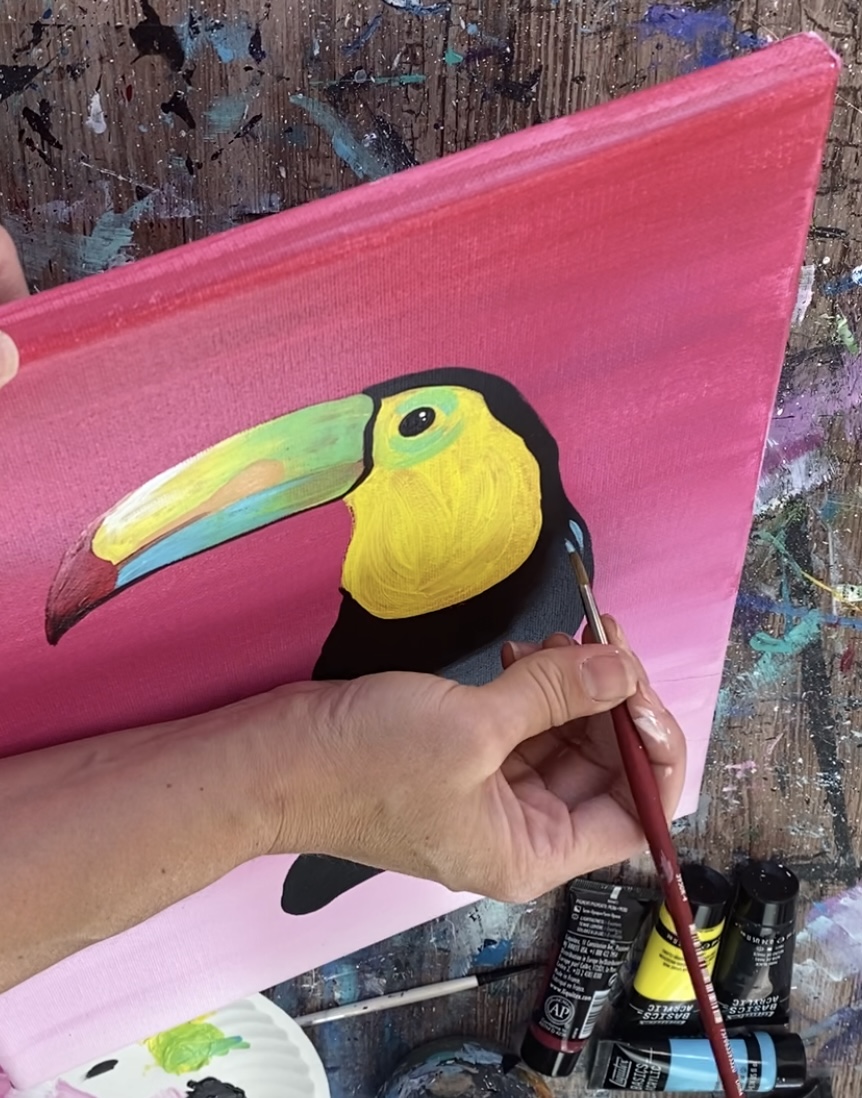
Load paint just on the tip of the brush! Paint curved, contouring strokes just on the right side of the bird on the black area.
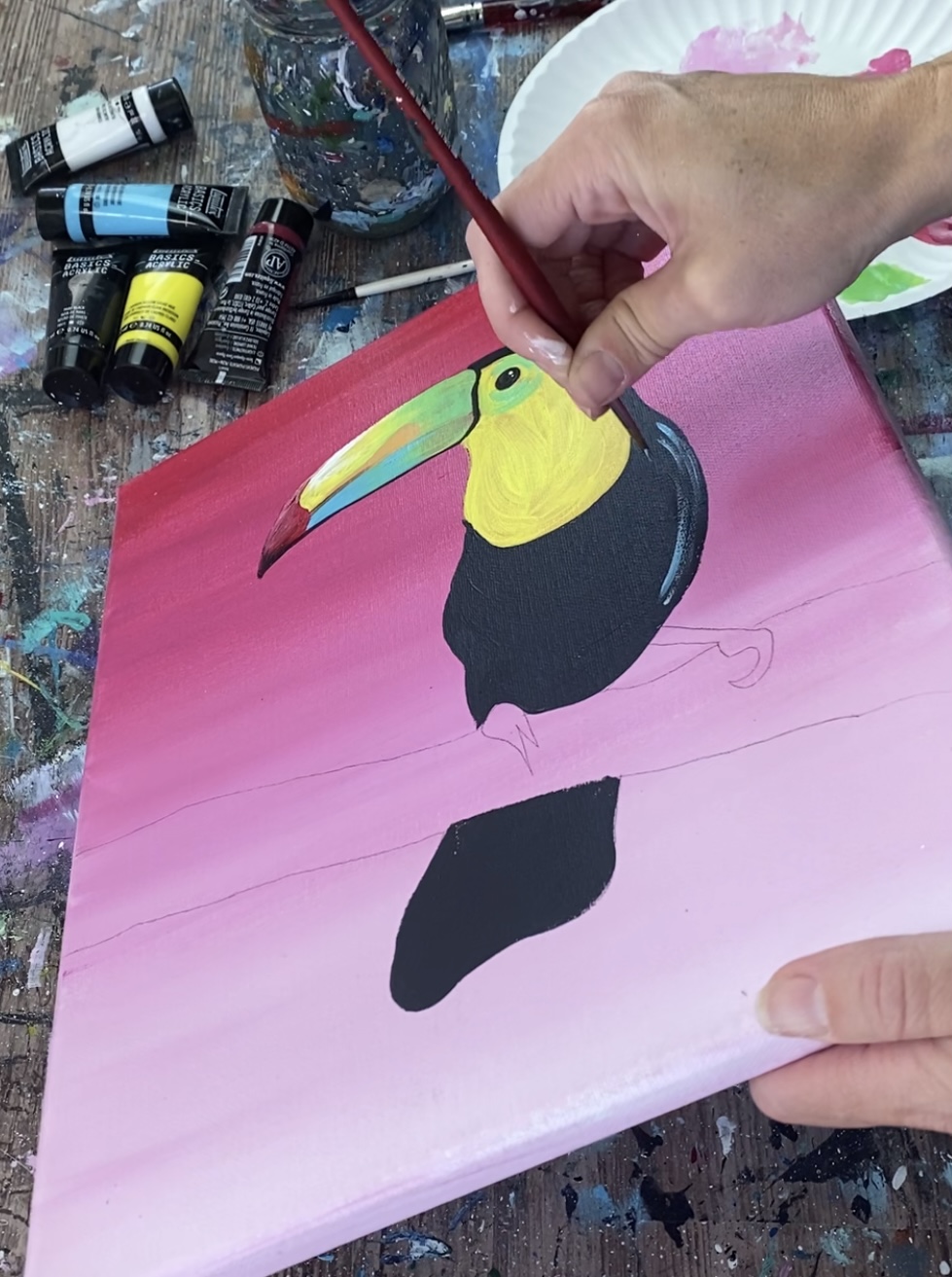
Do this on the tail as well.

8. Paint Legs
Paint the legs with light blue permanent and the #4 round brush. Then paint a small amount of black (for the shadow) towards the top of the legs and blend down into the blue.

9. Paint Branch
Load your palette with burnt umber. Use your #4 round brush to paint the branch. Paint in loose, long slightly wavy strokes.

Then use mars black to blend with the brown on the bottom of the branch. This is a dark shadowy area.

Use white to blend a lighter brown at the top of the branch. To create the texture in the branch, try not to over blend the white and black. Let the colors blend on the canvas to create a variation of that brown.

10. Paint Leaves
Use a POSCA Green paint pen to help you with the intricate details of the leaves. You can also use your small 10/0 round brush.
Draw two vines that go vertically down on each side of the toucan and curl slightly upwards.
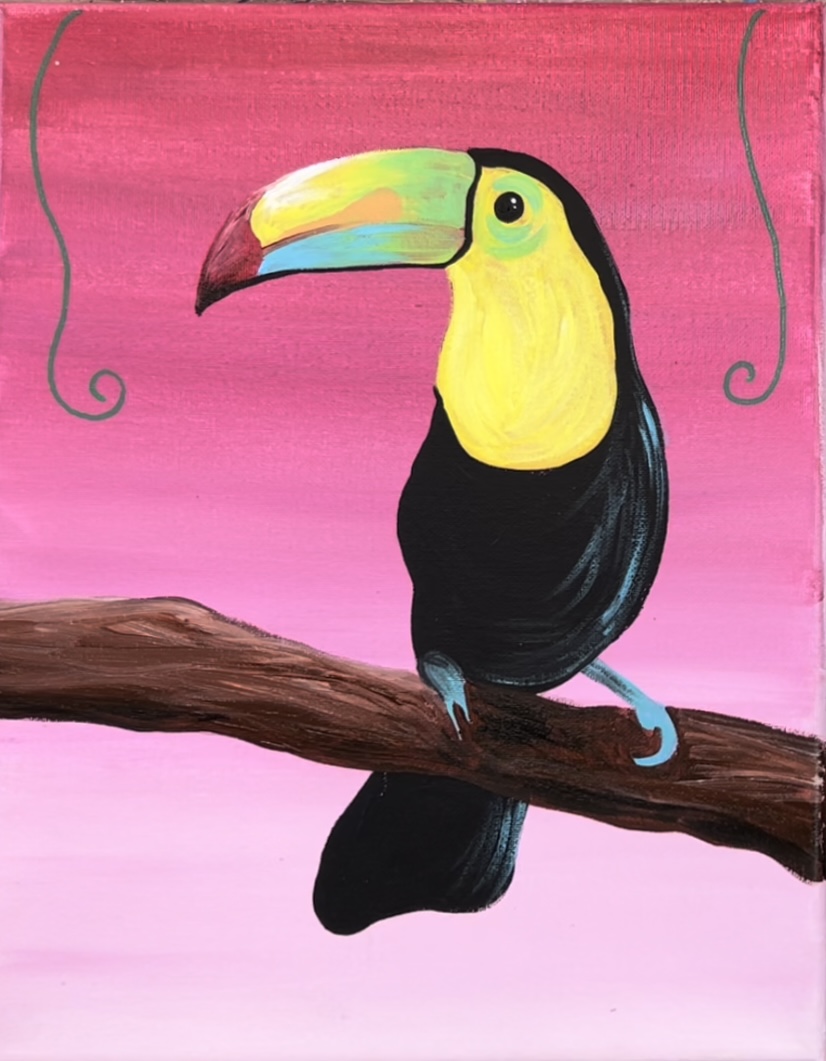
Then use your #4 round brush to paint little leaves on each side of the vine. Use hooker’s green hue permanent and titanium white. Double load the tip of your round brush in the green and white. Make small rounded leaves using just the tip of the brush.


Then paint a palm tree type of leaf. Use the hooker’s green and mix a small amount of alizarin crimson into it to darken the green. Paint leaves that are thick at the base and go to a point.

Draw the monstera leaf in the lower left corner with a pencil. These are leaves that have oblong openings on the edges and holes inside the leaves.
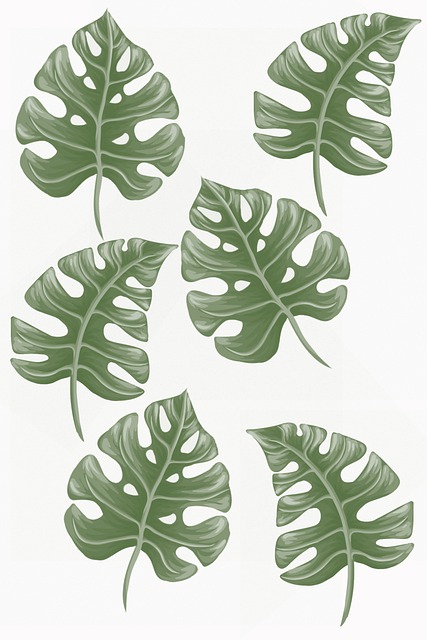

Then use your round brush and hooker’s green hue permanent/titanium white to paint the leaf. Make sure to paint around the oval shapes on the leaf to make it look like it has holes.
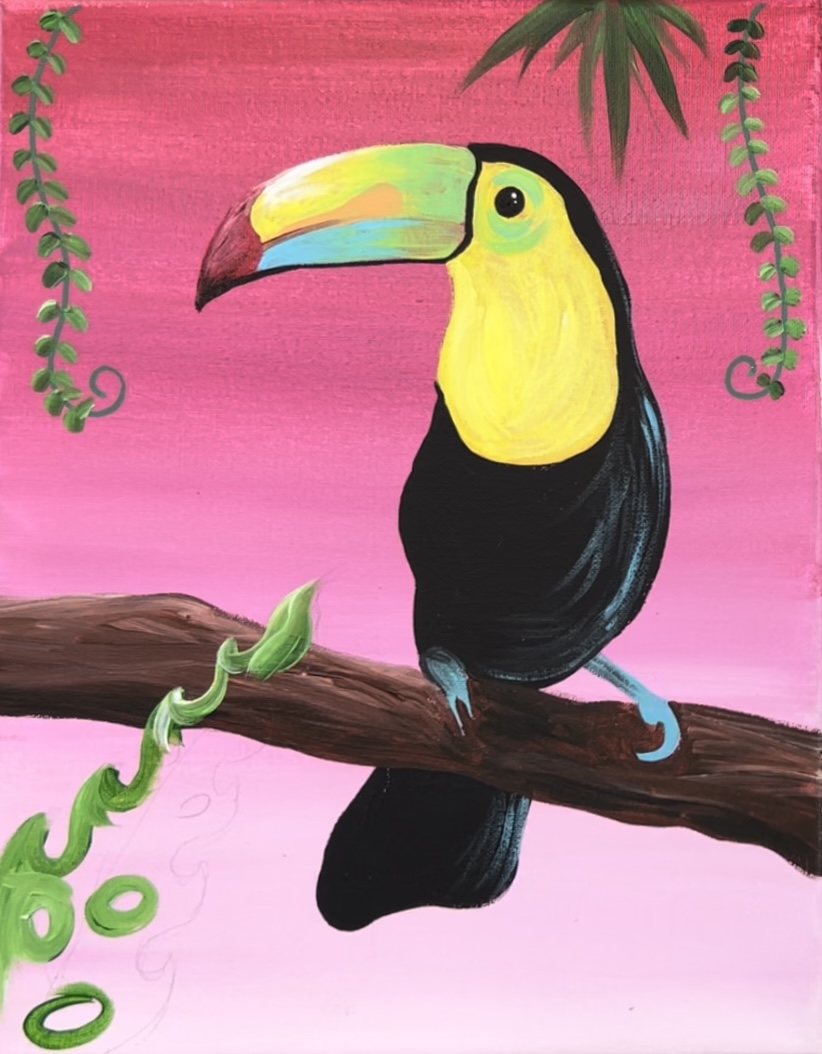
Let the green and white blend together on the canvas to create different variations of green.


Then use the POSCA Green Pen to draw a curved line in the lower right that goes over the branch. This will be the middle area of the palm tree frond.
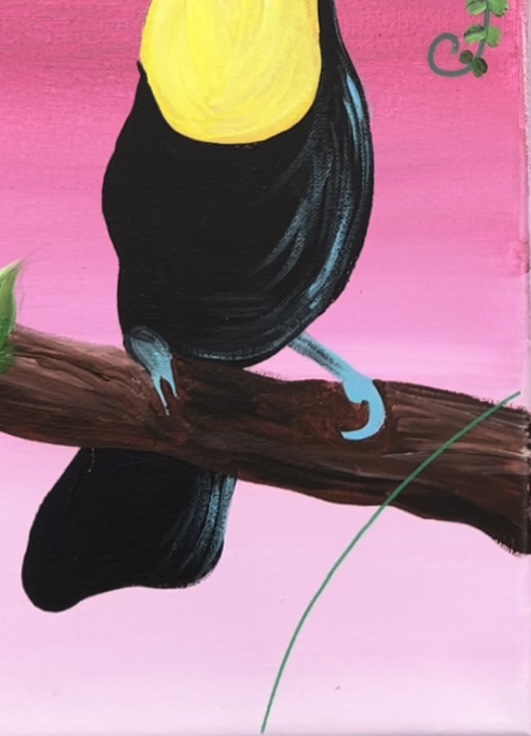
Then use the #4 round brush and hooker’s green hue mixed with a little titanium white to paint the palm leaves. Make the base of the leaf slightly wider and then go to a tip.
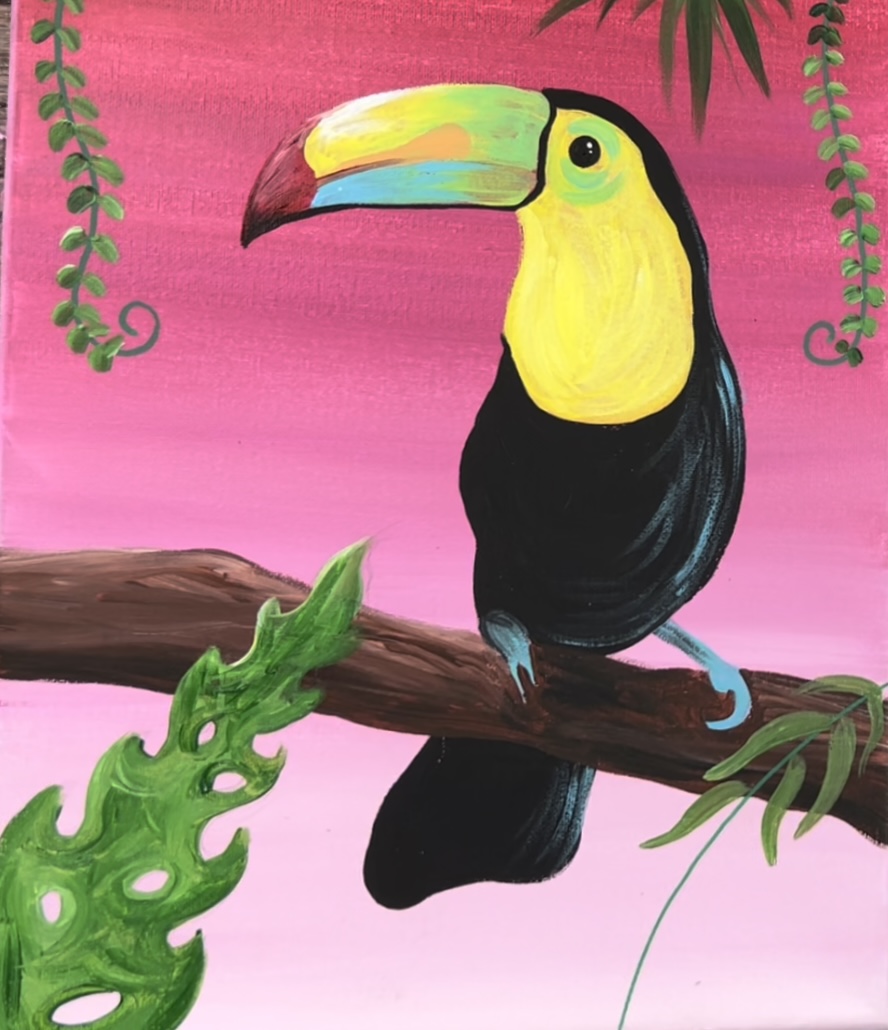
Each of the palm leaves angle downwards and are slightly wavy.

11. Paint Flowers
Use a round brush and titanium white to paint the petals of the plumeria flowers.

Paint five petals that slightly overlap each other and are more rounded/ almost pointed at the tip.

Then slightly outline one side of each of the petals with yellow. Paint a small dot in the center of the flower.

Then paint an orange plumeria next to it. Mix orange on your palette (the same orange that was used in the beak). Paint the petals first and then outline one side of each of the petals with alizarin crimson.

Add more details to your leaves such as highlights and veins. Paint more tropical leaves wherever you want around your toucan.

Finished!
Sign your name and show it off!


